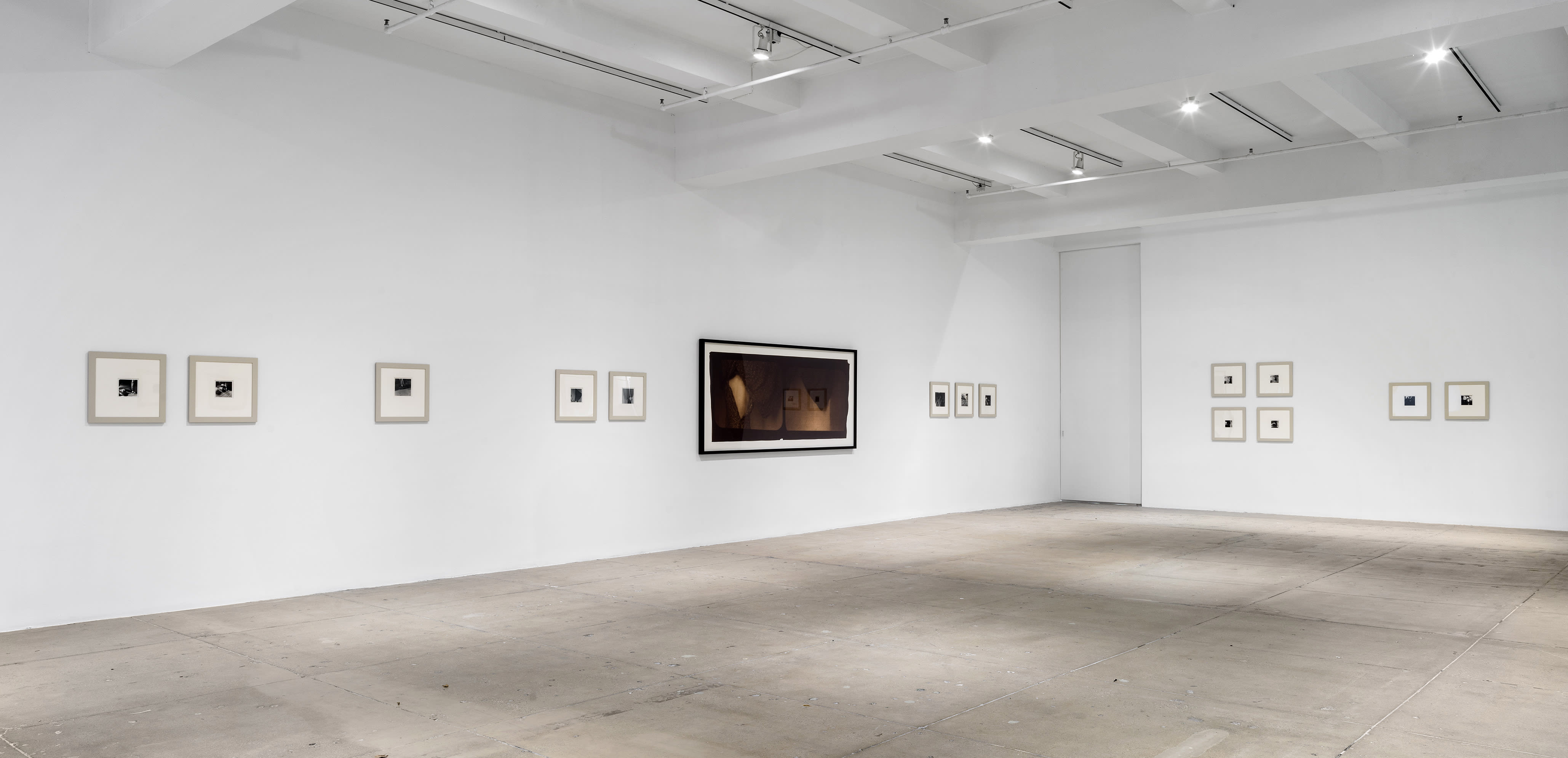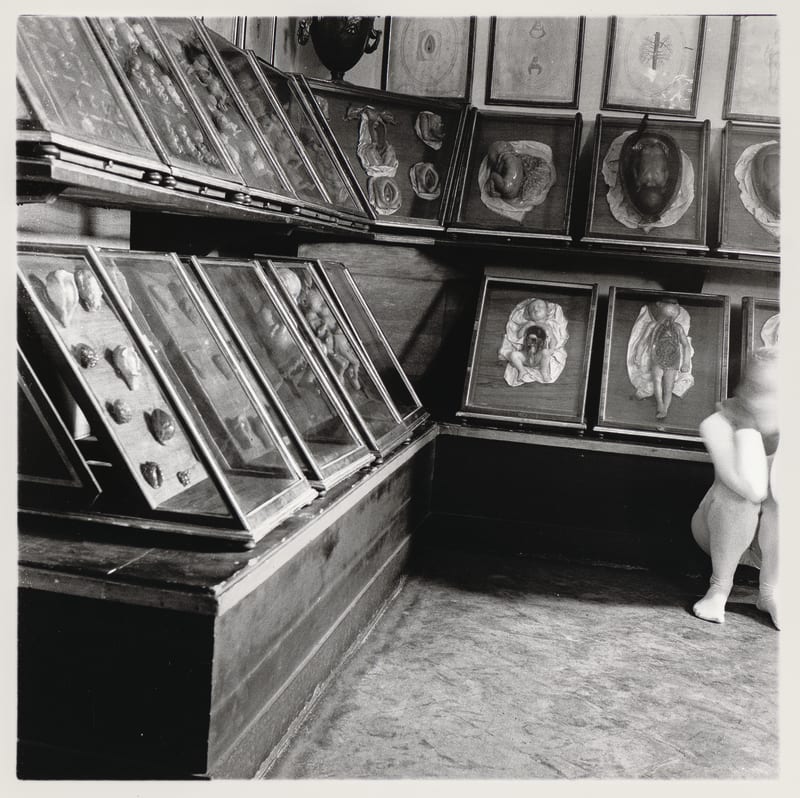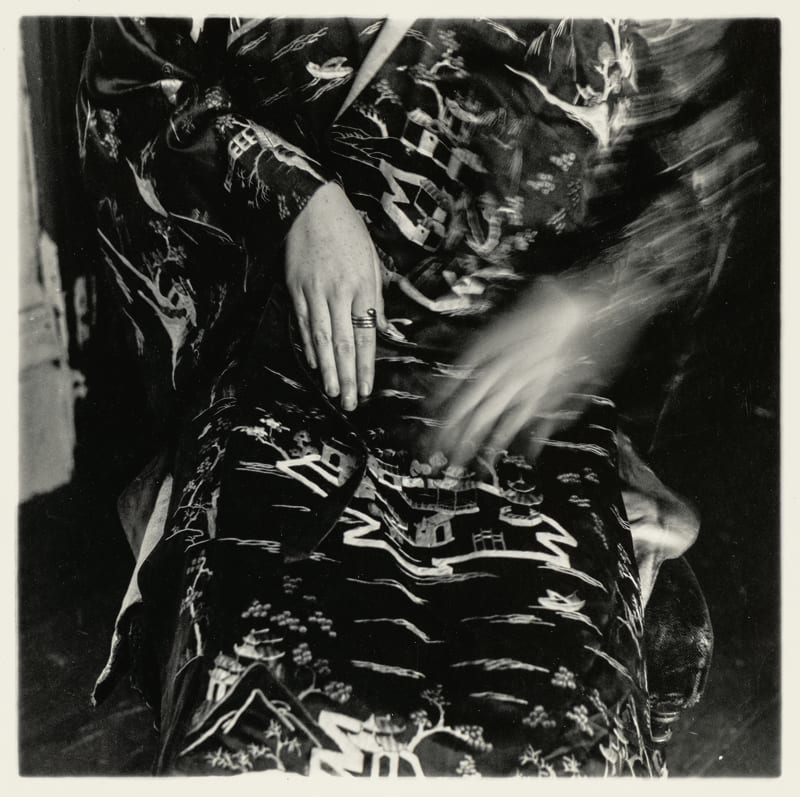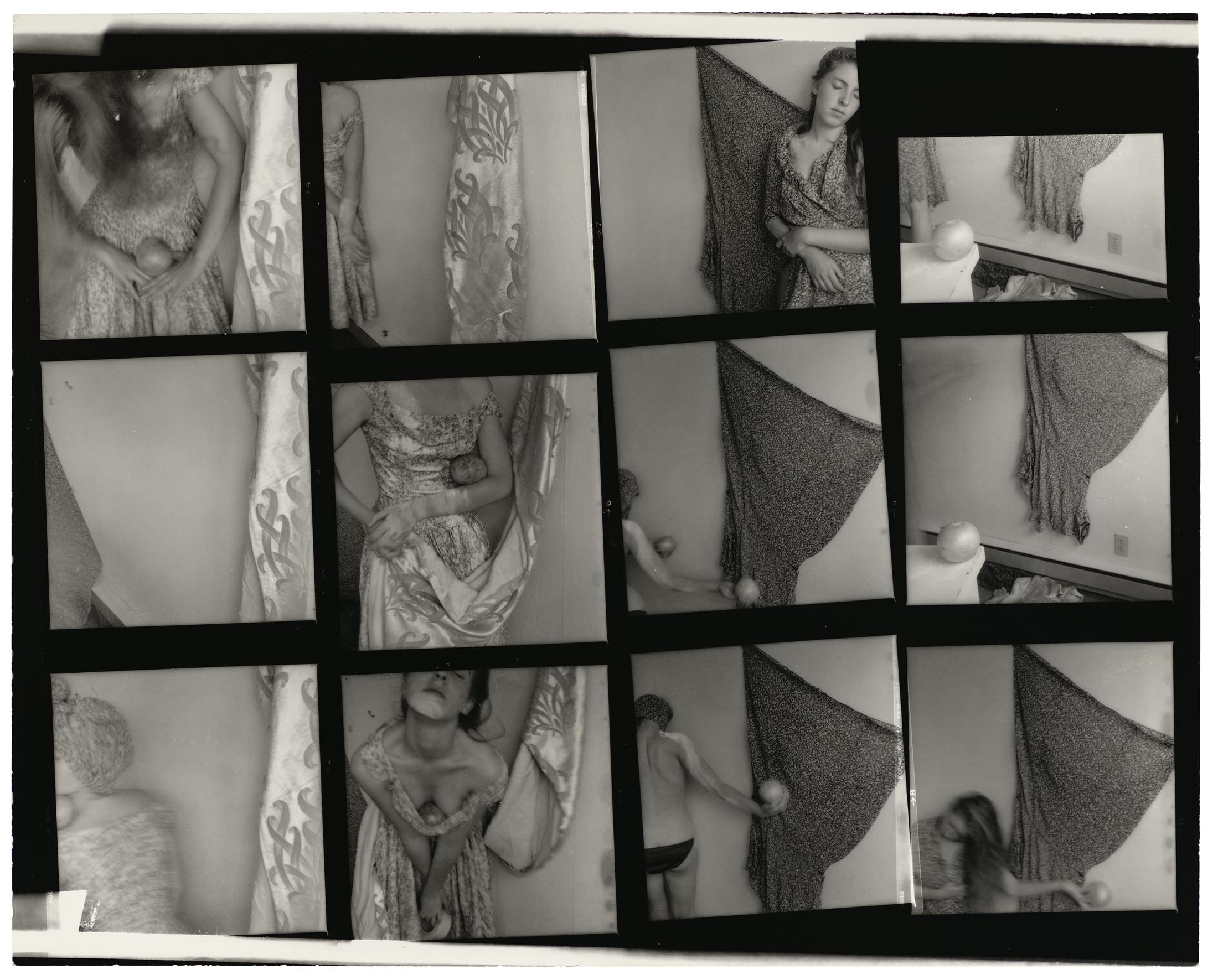Francesca Woodman: Alternate Stories
Francesca Woodman
Alternate Stories
2 November - 23 December 2021
Ann Gabhart on Francesca Woodman
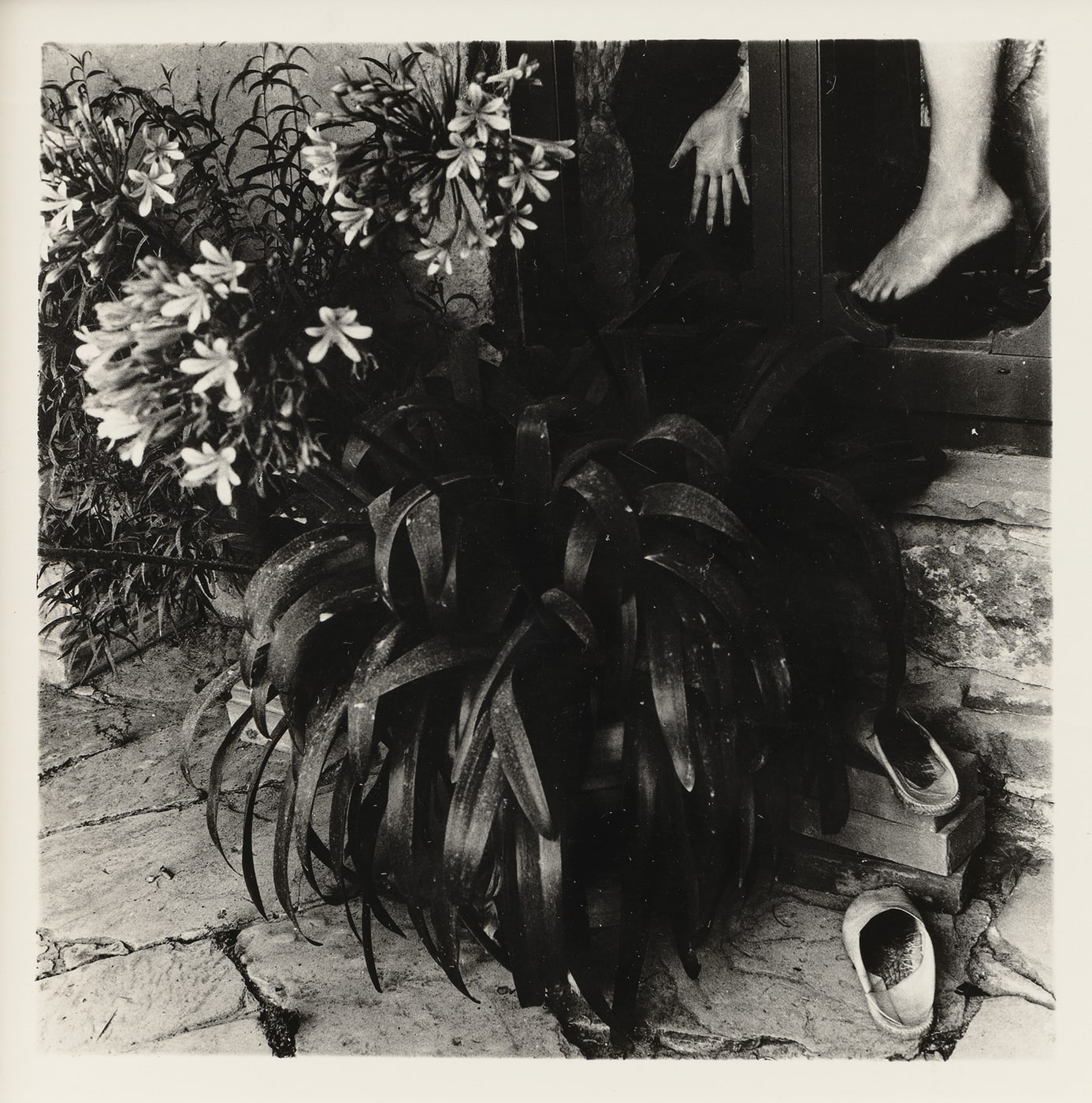
Frame: 18 1/4 x 18 1/4 x 5/8 in. (46.4 x 46.4 x 1.6 cm)
Marian Goodman Gallery is delighted to announce Francesca Woodman: Alternate Stories, a solo presentation of vintage photographs by Francesca Woodman, many of which have never been seen.
This presentation will be a departure from past exhibitions of the artist’s work, drawing on newly available vintage prints and archival material provided by the Woodman Family Foundation which offer a fresh glimpse into the varied thought processes, interests, and influences that motivated Woodman’s picture-making.
Download Press Release | Checklist | Woodman Family Foundation
All Images Courtesy of Woodman Family Foundation and Marian Goodman Gallery
© Woodman Family Foundation / Artists Rights Society (ARS), New York, 2021.
The presentation will move in and beyond key arcs of the artist’s creative life and will be clustered thematically to highlight special groupings of works in relational contexts which have heretofore not been seen.
Drew Sawyer on Francesca Woodman

A fully illustrated catalogue has been published on the occasion of the exhibition, featuring archival materials and a commissioned essay by critic and novelist Chris Kraus. Her essay, Impure Alchemy, examines the artist’s life via her work and explores the technical means and literary strategies that animate her photographs.
Francesca Woodman: Alternate Stories offers a compendium of images, which, as Kraus writes, still "inspire new mysteries and questions."
Francesca Woodman’s photographs are the result of an active mind at work. The exhibition highlights the deliberate construction of her images, a dialogue with art history, and her deep investment in the particularities of her medium. She both explored and harnessed the possibilities of photography through carefully conceived formal pursuits and remained fascinated by the magical properties of silver gelatin printing.
Elisabeth Sussman on Francesca Woodman
Chris Kraus on Francesca Woodman
Kraus’ essay addresses the artist as the architect of her own images, “constructing a kind of improvisational theater built around questions of space and time.” As Woodman herself wrote to the Italian editor Alberto Piovani, who was preparing a 1979 feature on her work for Progresso Fotografico, "i try to be intuitive, when I am actually taking the pictures i really only think about composition, not about content.“

Frame: 18 x 18 x 1 in. (45.7 x 45.7 x 2.5 cm)
Woodman’s photographs fuse compositional focus and technical mastery with her deep knowledge of literature and art history. In her grant application from 1980, Woodman reflects on her practice: “My early interest in literature followed me to Art school and the greatest influences on my work have been the writings of André Breton, specifically “Nadja” which is composed of some rather random photographs are expanded into the plot of the story, Collette and Zola. I feel [that] photographs can either document and record reality or they can offer images as an alternative to everyday life: Places for the viewer to dream in…”

Paper: 9 3/8 x 7 in. (23.8 x 17.8 cm)
Frame: 18 x 18 x 1 in. (45.7 x 45.7 x 2.5 cm)

Paper: 9 3/8 x 7 in. (23.8 x 17.8 cm)
Frame: 18 x 18 x 1 in. (45.7 x 45.7 x 2.5 cm)
An enigmatic set of images from Italy, 1978, depicts the artist in an unknown crumbling space, where the distinction between inside and outside has been lost. Caught in a reverie, with a stream of branches above her, she is set against this ruined building with the edge of a smile on her face. In the next, she is enveloped by a vegetal wall, with only her clasped hands revealing her presence. There is something fable-like about these images, the protagonist caught between a dreamscape and decomposing world.
During her years in Rome, Woodman frequented the Maldoror Bookstore, named after a hero of Comte de Lautréamont, a key reference point for the Surrealists. She befriended the owners, Giuseppe Casetti and Paolo Missigoi, and immersed herself in Futurist literature, Surrealist histories, and a dynamic coterie of young Italian artists, who also spent many hours at the shop.
The owners proposed a group exhibition based on the Symbolist etchings of Max Klinger. Her friend Sabina Mirri took Woodman to the grand and historic Fassi Bar, and from this visit grew a quartet of works featuring the two girls. Woodman’s photographs reimagine the story of the lost glove from Klinger’s etchings, shifting the focus from frame to frame between the two, and finally revealing the glove itself—a favorite trope of Surrealists—at the center of the story.
Sabina Mirri on Francesca Woodman

Francesca Woodman
Horizontale, Providence, Rhode Island, P.027 (A), 1976
Vintage gelatin silver print
Image: 5 1/4 x 4 7/8 in. (13.3 x 12.4 cm)
Frame: 18 x 18 x 1 in. (45.7 x 45.7 x 2.5 cm)

Frame: 18 x 18 x 1 in. (45.7 x 45.7 x 2.5 cm)
In the pair of prints Horizontale and Verticale, taken in 1976 while she was at Rhode Island School of Design, Woodman uses herself as material under the pretext of compositional studies. In the first, with a nod to Hans Bellmer, her legs tightly bound with ribbon, flesh bulging from its constraints, the direction of the bindings complicated by the diagonal construction of the rug beneath her; in the other, Francesca’s own tights hold the vertical lines; her blurred left-hand disrupting the vertical reading of the image. The images point to their own construction, and to the specific formal concerns she addressed while wryly commenting on the presentation of female bodies in the history of art.
![“I use nudes partely [sic] in an ironic sense like classical painting nudes. I want my pictures to have a...](https://artlogic-res.cloudinary.com/w_1400,h_1400,c_limit,f_auto,fl_lossy,q_auto/artlogicstorage/mariangoodman/images/view/b879026b61cd4adc0997300742442b05j.jpg)
Frame: 18 x 18 x 1 in. (45.7 x 45.7 x 2.5 cm)
“I use nudes partely [sic] in an ironic sense like classical painting nudes. I want my pictures to have a certain timeless, personal but allegorical quality like they do in say ingres [sic] history paintings, but I like the rough edge that photography gives a nude. I like watching the immidiacy [sic] of a photograph struggle with “timeless imagery” the way it does in say a pictorialist photograph” Woodman later wrote of her general approach. Woodman’s prescient fusion of subject and object in her photographs empowered a dynamic freedom and positive affirmation of the body in space, an expression at once serious, playful and transformative. Her interest in formal possibilities and texture of space, and how to affect appearance and disappearance within such spaces was a ripe area of exploration. "I am interested,” she writes, “in the way people relate to space. The best way to do this is to depict their interactions to the boundaries of these spaces."
Kevin Moore on Francesca Woodman
The enigmatic and theatrical images taken in 1976 at La Specola, Florence, a museum of eighteenth century anatomical waxworks and taxidermy, show Woodman in a white long-sleeved dancer’s leotard, positioning herself beneath and above the large-glass cases that dominate the space; in another, she crouches alongside wax models with exposed entrails. In these works, her blurred body and its white starkness actively respond to—and challenge—history and architecture. The three frames provide a loose narrative structure without a discernable ‘plot.’

Paper: 8 x 10 in. (20.3 x 25.4 cm)
Frame: 18 x 18 x 1 in. (45.7 x 45.7 x 2.5 cm)

Paper: 8 x 10 in. (20.3 x 25.4 cm)
Frame: 18 x 18 x 1 in. (45.7 x 45.7 x 2.5 cm)
“There's no doubt that Woodman was interested in the formal possibilities and texture of space-years later, she'd write in her diary, 'I am interested in the way people relate to space. The best way to do this is to depict their interactions to the boundaries of these spaces' - yet she must have also worked hard to create the theatrical excitement of this photograph. The image suggests a magic theater of incongruous carnival tricks. The viewer confronts an intriguing paradox of eroticized formalism.”
- Chris Kraus, Impure Alchemy, 2021
In a series of Untitled images from Providence, Rhode Island (1975-1978), cast plaster forms activate a sculptural relationship with the body and space. These images find parallels in other works from that time and place, in which the female body is visible only as a faint outline, behind a white sheet or enveloped within it, as if stretched before us on a fresh canvas.
In another series of images from this period Woodman is pictured lying on fabric and carpet, the floral design of her dress juxtaposed against a patterned backdrop. Untitled, Providence Rhode Island, 1975-78, features her visage craned far from the camera, her identity secondary to contour and form, reminiscent of Man Ray.
Stories in a new framework, the images are often informed by Woodman’s own writings and preparatory studies. Responding to elements of her practice, and the deliberate manner in which she sought to construct her work–from the personal and everyday to allegory–the works here can be seen as serial readings, corollaries to Woodman’s ways of seeing.
Isolde Brielmaier on Francesca Woodman

Paper: 10 x 8 in. (25.4 x 20.3 cm)
Frame: 17 7/8 x 17 7/8 x 3/8 in. (45.4 x 45.4 x .95 cm)

Paper: 8 x 10 in. (20.3 x 25.4 cm)
Frame: 18 x 18 x 1 in. (45.7 x 45.7 x 2.5 cm)
Francesca Woodman (1958-1981) was born into a family of artists in Colorado, and lived in Boulder, CO; Providence, RI; Antella and Rome, Italy; and New York City, until her death in 1981. Much of Woodman’s work was produced as a student at the Rhode Island School of Design in Providence, where she studied from 1975-1978. From 1977-78, Woodman lived in Rome as part of the RISD European Honors Program. She moved to the East Village in New York City in 1979, and was a fellow at MacDowell Colony in 1980. During her lifetime, Woodman had solo exhibitions at Addison Gallery of American Art, Andover, MA, 1976; Woods-Gerry Gallery, Rhode Island School of Design, Providence, RI, 1978; and Liberia Maldoror, Rome, 1978 and was included in group exhibitions at Galleria Ugo Ferranti, Rome, 1978 and the Alternative Museum, New York City, 1980, among others.
Rosalind Krauss on Francesca Woodman

Frame: 18 x 18 x 1 in. (45.7 x 45.7 x 2.5 cm)
The first in-depth, critical assessment of her work was organized by Ann Gabhart at Wellesley College Museum, Wellesley, MA in 1986, and was seen at Hunter College Art Gallery, New York, traveling to Boulder, Irvine, and Champlain, Il. A catalogue accompanied the exhibition, which includes influential early essays by Rosalind Krauss and Abigail Solomon-Godeau. A show at the Shedhalle Zurich in 1992 toured to Muenster, Stockholm, Helsinki; Berlin, and Norway; and in 2000 a solo exhibition was organized by Palazzo delle Esposizioni, Rome. A comprehensive show introducing her photographs to a wider public was organized by the Fondation Cartier pour l’art contemporain, Paris in 1998, and travelled to Rotterdam; Lisbon; London; Barcelona; Milan; Dublin; and Madrid.
A major retrospective was shown at the San Francisco Museum of Art, California in 2011 and traveled to the Guggenheim Museum, New York in 2012. In 2015, Moderna Museet, Stockholm, Sweden, organized and debuted On Being an Angel; which then traveled to Foam, Amsterdam, Netherlands, later that year; Fondation Henri Cartier Bresson, Paris, France, 2016; Moderna Museet, Malmo, Sweden, 2017; Finnish Museum of Photography, 2017; Fundacion Canal, Madrid, Spain, 2019; and C/O Berlin, Berlin, Germany, 2020. This year, the Light Society, Beijing, China will premiere an exhibition of her work, opening in October, 2021.
